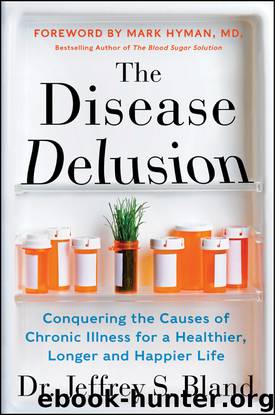The Disease Delusion by Jeffrey S Bland

Author:Jeffrey S Bland [Bland, Jeffrey S]
Language: eng
Format: epub
ISBN: 9780062290755
Publisher: HarperCollins
Published: 2013-03-11T04:00:00+00:00
Let’s start with how the energy gets produced. Again, that process takes place in the mitochondria and is called metabolism—specifically, aerobic metabolism. Simply put, the food matter you have ingested is burned—that is, combined with oxygen. This particular act of burning isn’t like throwing a log on the fire, however. On the contrary. The combustion process in the mitochondria is controlled very carefully so that the energy from the food does not wholly burn away like the heat from a wood fire in your fireplace. Instead, the process of mitochondrial bioenergetics captures the energy liberated during metabolism and stores it in the form of three specific chemical compounds—adenosine triphosphate, or ATP; nicotinamide dinucleotide, NADH; and flavin adenine dinucleotide, or FADH. These storage chemicals then allow the energy to be transferred to other sites within the tissue where the energy powers up the cells to do the work that cells do—contracting muscles, transporting signals, keeping the brain moving, repairing tissue, and everything else that supports the body’s core physiological processes. ATP, NADH, and FADH are our cells’ energy fuels. In essence, everything we do depends on the production and management of these cellular energy fuels that in turn rely on proper mitochondrial function.
If that’s the case, what’s the secret to ensuring proper mitochondrial function? Remember back in Chapter 2 when we talked about how some of the genetic information in our mitochondria comes exclusively from our mother—our maternal DNA? That means that our mitochondrial bioenergetics is to some extent inherited, but only just. In reality, mitochondrial function is regulated by thousands of genes, the vast majority of which are influenced in their expression by our lifestyle, environment, and diet. That also means that most of our energy as we age is controlled by the interaction of our genes with environmental and lifestyle factors. Our surroundings, what we eat, how and how much we exercise: all these factors influence our energy level because all send messages to the genes that regulate our mitochondrial function. So the secret to ensuring mitochondrial function is, once again, what happens at that intersection between environment and our genes.
Yes, the core physiological process of mitochondrial bioenergetics diminishes as we grow older, but by adjusting our environment, lifestyle behaviors, and diet, we clearly have a shot at making our bioenergetics more efficient, thereby retarding that diminution or keeping it at bay a lot longer. What should we know, therefore, especially as we age, about the particular factors that can influence the genetic expression regulating our mitochondrial function? That’s what this chapter is all about.
Download
This site does not store any files on its server. We only index and link to content provided by other sites. Please contact the content providers to delete copyright contents if any and email us, we'll remove relevant links or contents immediately.
Men In Love by Nancy Friday(5192)
Everything Happens for a Reason by Kate Bowler(4700)
The Immortal Life of Henrietta Lacks by Rebecca Skloot(4548)
Why We Sleep by Matthew Walker(4394)
The Sports Rules Book by Human Kinetics(4339)
Not a Diet Book by James Smith(3373)
The Emperor of All Maladies: A Biography of Cancer by Siddhartha Mukherjee(3111)
Sapiens and Homo Deus by Yuval Noah Harari(3027)
Day by Elie Wiesel(2745)
Angels in America by Tony Kushner(2623)
A Burst of Light by Audre Lorde(2568)
Endless Forms Most Beautiful by Sean B. Carroll(2442)
Hashimoto's Protocol by Izabella Wentz PharmD(2348)
Dirty Genes by Ben Lynch(2291)
Reservoir 13 by Jon McGregor(2264)
Wonder by R J Palacio(2182)
And the Band Played On by Randy Shilts(2163)
The Immune System Recovery Plan by Susan Blum(2040)
Stretching to Stay Young by Jessica Matthews(2011)
